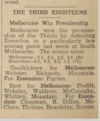- Dec 17, 2006
- 4,773
- 5,217
- AFL Club
- Collingwood
- Other Teams
- South Fremantle, Sturt
These two games are the only ones where teams have trailed by more than 10 goals at 3/4 time and lost by less than 4 goals (I don't have "in play" scores, just qtr. by qtr. ones):
View attachment 2186052
View attachment 2186053
And this one doesn't quite qualify, but it's close enough for me to throw it in!:
View attachment 2186054
Thanks, I thought such games would be rare. I should have guessed that Melbourne 1993 would be on the list, this Demons team could well take the prize for the most enigmatic side to ever take the field. And also Geelong vs. Swans, put the Cats and Swans together and they produce all sorts of crazy stats. Sort of like Richmond and St Kilda, the Saints and Tigers aren't big rivals and have never met in a Grand Final (the only Victgorian team aside from University the Tigers have never met in the Grand Final), but Richmond and St Kilda have a long list of weird statistical anomalies from their games over the years.






